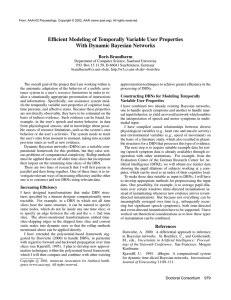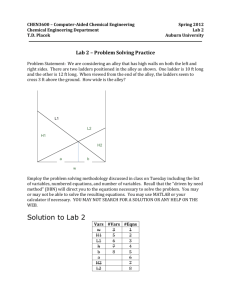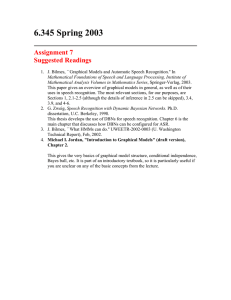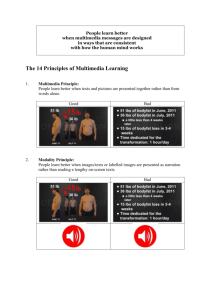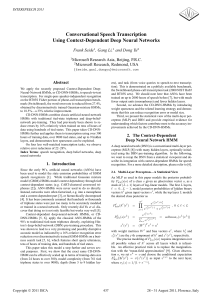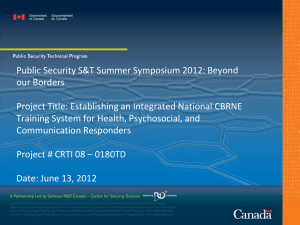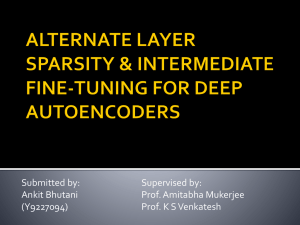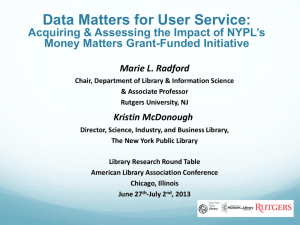Deep Belief Nets as Function Approximators for Reinforcement Learning
advertisement
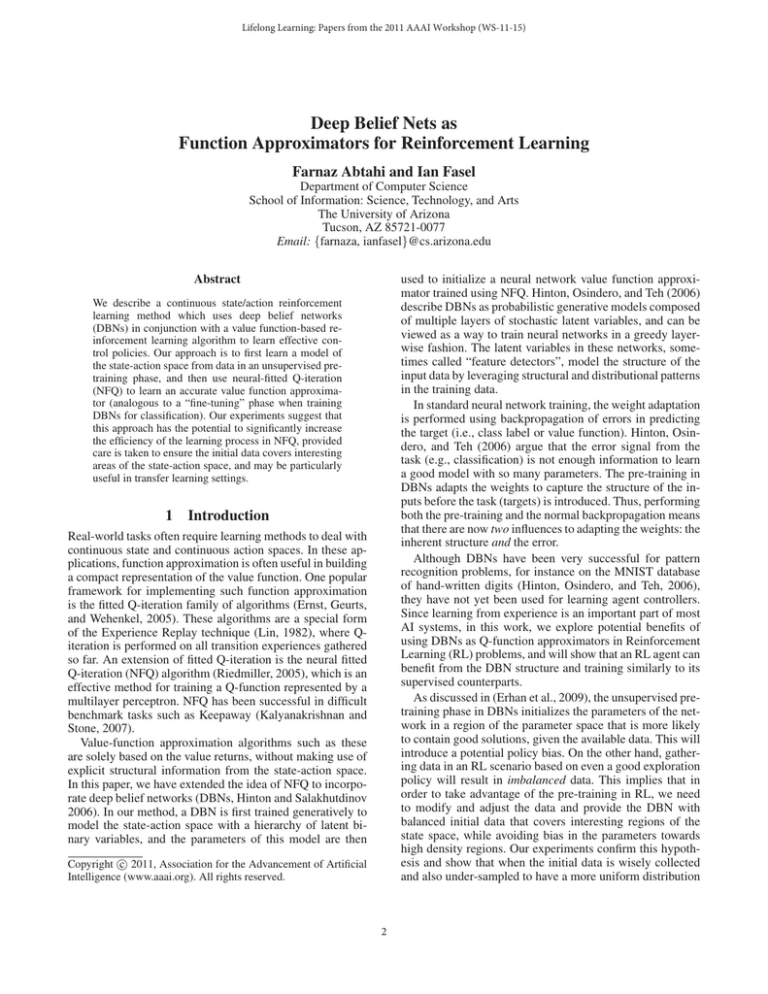
Lifelong Learning: Papers from the 2011 AAAI Workshop (WS-11-15)
Deep Belief Nets as
Function Approximators for Reinforcement Learning
Farnaz Abtahi and Ian Fasel
Department of Computer Science
School of Information: Science, Technology, and Arts
The University of Arizona
Tucson, AZ 85721-0077
Email: {farnaza, ianfasel}@cs.arizona.edu
used to initialize a neural network value function approximator trained using NFQ. Hinton, Osindero, and Teh (2006)
describe DBNs as probabilistic generative models composed
of multiple layers of stochastic latent variables, and can be
viewed as a way to train neural networks in a greedy layerwise fashion. The latent variables in these networks, sometimes called “feature detectors”, model the structure of the
input data by leveraging structural and distributional patterns
in the training data.
In standard neural network training, the weight adaptation
is performed using backpropagation of errors in predicting
the target (i.e., class label or value function). Hinton, Osindero, and Teh (2006) argue that the error signal from the
task (e.g., classification) is not enough information to learn
a good model with so many parameters. The pre-training in
DBNs adapts the weights to capture the structure of the inputs before the task (targets) is introduced. Thus, performing
both the pre-training and the normal backpropagation means
that there are now two influences to adapting the weights: the
inherent structure and the error.
Although DBNs have been very successful for pattern
recognition problems, for instance on the MNIST database
of hand-written digits (Hinton, Osindero, and Teh, 2006),
they have not yet been used for learning agent controllers.
Since learning from experience is an important part of most
AI systems, in this work, we explore potential benefits of
using DBNs as Q-function approximators in Reinforcement
Learning (RL) problems, and will show that an RL agent can
benefit from the DBN structure and training similarly to its
supervised counterparts.
As discussed in (Erhan et al., 2009), the unsupervised pretraining phase in DBNs initializes the parameters of the network in a region of the parameter space that is more likely
to contain good solutions, given the available data. This will
introduce a potential policy bias. On the other hand, gathering data in an RL scenario based on even a good exploration
policy will result in imbalanced data. This implies that in
order to take advantage of the pre-training in RL, we need
to modify and adjust the data and provide the DBN with
balanced initial data that covers interesting regions of the
state space, while avoiding bias in the parameters towards
high density regions. Our experiments confirm this hypothesis and show that when the initial data is wisely collected
and also under-sampled to have a more uniform distribution
Abstract
We describe a continuous state/action reinforcement
learning method which uses deep belief networks
(DBNs) in conjunction with a value function-based reinforcement learning algorithm to learn effective control policies. Our approach is to first learn a model of
the state-action space from data in an unsupervised pretraining phase, and then use neural-fitted Q-iteration
(NFQ) to learn an accurate value function approximator (analogous to a “fine-tuning” phase when training
DBNs for classification). Our experiments suggest that
this approach has the potential to significantly increase
the efficiency of the learning process in NFQ, provided
care is taken to ensure the initial data covers interesting
areas of the state-action space, and may be particularly
useful in transfer learning settings.
1
Introduction
Real-world tasks often require learning methods to deal with
continuous state and continuous action spaces. In these applications, function approximation is often useful in building
a compact representation of the value function. One popular
framework for implementing such function approximation
is the fitted Q-iteration family of algorithms (Ernst, Geurts,
and Wehenkel, 2005). These algorithms are a special form
of the Experience Replay technique (Lin, 1982), where Qiteration is performed on all transition experiences gathered
so far. An extension of fitted Q-iteration is the neural fitted
Q-iteration (NFQ) algorithm (Riedmiller, 2005), which is an
effective method for training a Q-function represented by a
multilayer perceptron. NFQ has been successful in difficult
benchmark tasks such as Keepaway (Kalyanakrishnan and
Stone, 2007).
Value-function approximation algorithms such as these
are solely based on the value returns, without making use of
explicit structural information from the state-action space.
In this paper, we have extended the idea of NFQ to incorporate deep belief networks (DBNs, Hinton and Salakhutdinov
2006). In our method, a DBN is first trained generatively to
model the state-action space with a hierarchy of latent binary variables, and the parameters of this model are then
c 2011, Association for the Advancement of Artificial
Copyright Intelligence (www.aaai.org). All rights reserved.
2
of the state space, our approach can significantly increase
the sample efficiency of NFQ.
2
mizes the variance and introduces a bias towards configurations of the parameters that stochastic gradient descent can
explore during the supervised learning phase, by defining a
data-dependent prior on the parameters obtained through the
unsupervised learning. In other words, pre-training implicitly imposes constraints on the parameters of the network to
specify which minimum out of all local minima of the objective function is desired. The effect of pre-training relies on
the assumption that the true target conditional distribution
P (Y |X), shares structure with the input distribution P (X).
For non-convex optimization problems, SGD methods
have the problem that they can often be driven to poor solutions by the order in which training examples are seen,
particularly if the data is highly imbalanced. As explained
by (Provost, 2000), many learning algorithms suffer from
data imbalance because of the following assumptions that
are built into them:
Background
DBNs are probabilistic graphical models built by stacking up restricted Boltzmann machines (RBMs) (Smolensky,
1987). An RBM is an undirected graphical model that consists of one layer of visible and one layer of hidden Bernoulli
random variables (or units), with no connections between
units of the same layer. Connections between layers are
bi-directional and symmetric, which means both directions
share the same weights and information flows in both directions. Fig. 1 (left) shows an RBM with 4 visible and 3 hidden
units. A sample DBN is illustrated in Fig. 1 (right).
DBN
h3
RBM
h0
v0
h2
h1
v1
v2
• The goal is to maximize the accuracy, and
• The learning algorithm will operate on the data drawn
from the same distribution as the training data.
h2
v3
As a result, machine learning techniques can produce unacceptable results if trained on imbalanced datasets. For instance, suppose 99% of the samples used to train a classifier
come from one class. Then the learning algorithm can try to
achieve the best possible accuracy by assigning everything
to the majority class. The problems of imbalanced data can
be especially pronounced in RL applications in which the
value function is represented by a function approximator. In
this case, since data collection is performed by executing
some inherently biased policy, the value function approximator will ignore regions of the state space where little data
is available. Although Erhan et al. (2010) found the strong
effect of early examples was diminished in DBNs in an experiment with an online form of MNIST, it seems plausible
that this could still be a problem for DBNs in RL if pretraining is viewed as a regularizer which defines a bias towards regions of the state space that are similar to the pretraining data.
Many techniques can be applied to solve the problem of
imbalanced data. A possible approach is to manually balance
the data by adding samples from minority classes or regions
where it is hard to collect data. The hint-to-goal huristic used
by Riedmiller (2005) is an example of this approach. In RL
domains, another way of balancing the data is to use a better
sampling strategy by adding traces of an efficient policy to
the training data.
Two other common methods for artificially balancing the
data are under-sampling (ignoring samples from the majority), and over-sampling (replicating cases from the minority). These techniques and many other methods are discussed in (Chawla, Japkowics, and Kotcz, 2004). We explore
a form of informed undersampling (Liu, Wu, and Zhou,
2009; Drummond and Holte, 2003) at the end of this paper and find that this can indeed dramatically enhance the
ability of DBNs to improve NFQ.
h1
x
Figure 1: An RBM with 4 visible (input) and 3 hidden units
(left) and a DBN with the same number of units in all layers
(right).
DBNs can be trained using the contrastive divergence
(CD) algorithm (Hinton, 2002) to extract a deep hierarchical representation of the training data. During the learning
process, the DBN is first trained one layer at a time, in a
greedy unsupervised manner, by treating the values of hidden units in each layer as the training data for the next layer
(except for the first layer, which is fed with the raw input
data). This learning procedure, called pre-training, finds a
set of weights that determine how the variables in one layer
depend on the variables in the layer above. These parameters capture the structural properties of the training data. If
the network is to be used for a classification task, then a supervised discriminative fine-tuning is performed by adding
an extra layer of output units and backpropagating the error
derivatives (using some form of stochastic gradient descent,
or SGD).
Erhan et al. (2009) studies the reasons why pre-trained
deep networks work much better than traditional neural networks and proposes several possible explanations. One possible explanation is that pre-training initializes the parameters of the network in an area of parameter space where
optimization is easier and a better local optima is found.
This is equivalent to penalizing solutions that are outside a
particular region of the solution space. Another explanation
is that pre-training acts as a kind of regularizer that mini-
3
3
Combining DBNs and RL
4
The basic idea underlying combining DBNs with RL is to
take advantage of the unsupervised pre-training phase in
DBNs, and then use the DBN as the starting point for a neural network function approximator for representing the Qfunction. This points us towards extending the popular neural fitted Q-iteration framework to a version in which the
Q-function is approximated with a DBN. Our proposed algorithm is displayed in Algorithm 1.
4.1
Experiments
The effect of pre-training on the efficiency of
learning
In our first set of experiments, we would like to test if pretraining improves the performance in some standard benchmark RL problems. The first domain we have selected for
this purpose is the Mountain Car problem in which the system has to reach a certain area in state space, and the task
will immediately terminate as soon as it gets there. We will
use the same settings as Riedmiller (2005) for the cost function and system specifications. For the network, we used two
hidden layers with 5 units in all cases, as in (Riedmiller,
2005).
The learning process consists of 500 episodes. Each
episode begins with generating a 50-step trajectory, using
the current estimate of the Q-function. Then this trajectory
is added to the training set and the entire set is fed to the neural network to learn a new approximation of the Q-function.
After the network is trained, target values of the training set
are updated given the new estimate of the Q-function.
The system performance is tested after every 10 episodes
of learning. The test set comprises 1000 random initial
points in the state space and the system has to reach the goal
region starting from each of these initial points within 250
steps. The performance is defined as the percentage of the
tests that are completed successfully.
We initialize our training set in two different ways. In
first case, the initial data is a 50-step random walk in the
state space. We collect this data by running a completely
random policy. In second case, in addition to the 50-step
random walk, we also use the ”hint-to-goal huristic” from
Riedmiller (2005) and add 100 artificially generated random points from near the goal region to the training set.
This makes our experiments a more fair comparison with
the work of Riedmiller (2005).
The above settings and also whether we start the learning process with or without pre-training on the initial dataset
will form the four cases of our experiment:
Algorithm 1 DeepRL
Input: a set of transition samples D, a binary flag
pretrain;
Output: Q-value function QN
k←0
if pretrain = true then
Q0 ← pretrain DBN(D)
else
Q0 ← rand init DBN
end if
repeat
get new experiences P = {(inputi , targeti )} where:
inputi ← (si , ai )
targeti ← c(si , ai , si ) + γmina Qk (si , a )
D ← append(D, P )
Qk+1 ← train DBN(D)
k ←k+1
for all (inputj , targetj ) in D do
targetj ← c(sj , aj , sj ) + γmina Qk (sj , a )
end for
until K = N or Qk ≈ Qk−1
The algorithm consists of two main steps. First, the training set and the DBN are initialized. Depending on the setting that we would like to use in a particular experiment, we
can use different initializations. The initial transition samples are a set of < state, action, target > tuples. If we
decide to start with unsupervised pre-training, the DBN is
pre-trained on the set of transition samples, without taking
the target values (i.e., return estimates) into account.
The second step of the algorithm is the reinforcement
learning loop. From this point on, the algorithm works similar to the NFQ approach and the DBN weights are used as
the initial configuration of a regular neural network value
function approximator. This part of the algorithm begins
with using the current Q-function for a greedy policy which
is run in the environment to gather an additional set of experiences, which are then attached to the initial training set.
Afterwards, the combined set is used to update the network
and get a new estimate of the Q-function. This is done by
using the current Q-function to recalculate the target values for every experience tuple in the updated training set,
and then SGD is used to update the value function outputs.
These steps are repeated N times, or until the Q-function
converges and the updated targets are successfully learned.
To show progress, we periodically test the current policy in
the environment without using those experiences for learning.
• Without pre-training, without hint-to-goal
• Without pre-training, with hint-to-goal
• With pre-traing, without hint-to-goal
• With pre-training, with hint-to-goal
Note that the second case is in fact equivalent to the NFQ
approach presented in (Riedmiller, 2005).
Figure 2 (top) shows the results of the above four cases,
averaged over 40 replications of the experiment with different random seed. Comparing with vs. without pre-training
curves indicates that pre-training helps, especially at the beginning of learning, and this is true both for with and without
hint-to-goal heuristic.
As mentioned in previous sections, pre-training seems to
introduce a bias towards configurations of the parameters
that are more desirable for later gradient learning steps. This
explains why the case with the hint-to-goal heuristic shows
better performance when learning begins with a pre-training
phase. In this case the DBN learns that the goal is more
4
area of the state space too dissimilar from the states experienced when the agent is performing well, thereby reducing
the ability of later data from improved policies to influence
the weight configuration.
%&
4.2
Although these initial results are promising and it seems
credible to use DBNs to improve function approximation
in NFQ, the results of Erhan et al. (2009) makes us think
that there might be an additional advantage in pre-training.
If we give the deep nets some good data up-front, it puts the
parameters of the DBN in a better region of the parameter
space to learn from. This means that it might be very good
for a transfer learning setting, where we already know something about the task, but need to do some more learning.
In order to test this idea, in our second experiment we repeat the case where pre-training is done on a random walk,
and then compare it with another case where the pre-training
set is a 50-step trace of a good policy instead of a random
walk. This “good” policy is chosen from those policies obtained during the first experiment that attained 100% success. The result of this experiment is quite surprising.
In Mountain Car domain, a random policy mostly ends up
in the valley because of the gravity effect and remains stuck
in that area. So a trace of a random policy by no means covers all the interesting areas of the state space. On the other
hand, a good policy can escape the valley more easily and
get to other regions of the space. This means that an agent
with this policy will explore the entire state space more thoroughly, thus the training set is more balanced. Fig. 3 (top)
confirms that when pre-training a DBN with initial data from
a “good” policy, the resulting policy trained with NFQ can
significantly outperform the one trained on a random walk.
Contrarily, as we can see in Fig. 3 (bottom), the trajectory generated by the random policy seems to be much more
helpful than the trajectory obtained from a good policy in
Puddle World. The intuitive explanation for this is that unlike Mountain Car, a random policy in Puddle World can
cover almost every possible area of the space, while a good
policy might always avoid the puddle and the area around it.
So with a good policy, the agent will not have any information about how good or bad it is to be inside the puddle. The
result is that the DBN pre-training initializes the weights in
such a way that it is apparently very difficult to learn a representation of the value function for important (perhaps importantly bad) parts of the state space, greatly hurting the
performance of the agent.
!"#$$!
!"$!
$!"#$$!
$!"$!
Providing the DBN with good initial data
!"#$$!
!"$!
$!"#$$!
$!"$!
Figure 2: Comparison of the performance during learning
with/without pre-training and with/without the hint-to-goal
heuristic, averaged over 40 trials in Mountain Car (top) and
Puddle World (bottom).
likely to be around the points which are more often seen
in the training data.
However without hint-to-goal, it seems that pre-training
only make a little difference, if any. This may be because
a random walk is not a good enough representative of the
desirable regions of the state space, since the system often
gets stuck at the bottom of the hill and the data collected
during random walk will be highly imbalanced and mostly
includes points inside the valley.
This is even clearer in Fig. 2 (bottom), where we repeat
the same experiment on our second domain, Puddle World.
In this case, the environment is a 2-dimensional grid world
with a puddle located in a random position on the grid. The
agent tries to reach the goal area, which is at a corner of the
grid, while avoiding the puddle. All the experiment settings
are as before, except that learning continues for 150 episodes
and the performance is tested after each 5 episodes over a
set of 1000 random starting points. As we can see, in case
of absence of hint-to-goal, pre-training seems to do nothing,
or perhaps even slightly hurt performance. We believe this
may be because pre-training with trajectories generated by
a random policy may be biasing the parameters towards an
4.3
Under-sampling the training data
The idea of providing the DBN with a good trajectory
(which can be a trace of a good policy, or even a random
walk, depending on the domain), to some extent deals with
the issue of imbalanced data in the sense that it covers the
areas of the state space that are normally hard to reach.
This makes DBNs an appropriate tool for transfer learning.
The problem with this method is that it can generate several redundant samples in the state space which can have
the effect of increasing the data imbalance problem. In order
5
Mountain Car
60
70
55
55
65
Success rate
rate in
Success
in 1000
1000tests
tests
Success rate in 1000 tests
Mountain Car
60
50
45
40
35
30
45
55
40
50
35
45
30
40
Pretrained on a good trajectory
Pretrained on a random walk
25
20
50
60
0
100
200
300
Number of episodes
400
Pretrained on a set of 10 good
trajectories
Pretrained on a good trajectory
Pretrained on an undersampled
Pretrained
on atrajectories
random walk
set of 10 good
25
35
20
30
00
500
100
100
80
65
55
70
60
50
40
30
20
50
100
Number of episodes
50
40
45
35
Pretrained on a set of a random
walk and 10 good trajectories
Pretrained on an undersampled
Pretrained
on a good trajectory
set of a randomwalk
and 10
good trajectories
Pretrained
on a random walk
40
30
30
20
0
0
150
Figure 3: Comparison of the performance during learning
when the pre-training data is 1) a random walk, and 2) a
good trajectory generated by a successful policy, in Mountain Car (top) and Puddle World (bottom). Both curves are
averaged over 40 trials.
100
100
200
300
200
300
Number of episodes
Number of episodes
400
400
500
500
Figure 4: The effect of under-sampling the pre-training data
in Mountain Car problem.
data covers the desirable areas of the state space, but highly
inefficient if the data does not cover much of the state space.
We also tried to address the problem of imbalanced data
that often arises in RL problems, and which still (apparently) can cause problems in DBNs. For this purpose, we
first added some datapoints around the goal region in the
state space that were manually generated using the hint-togoal heuristic to the initial data and used this set to pre-train
the DBN. Then, we also added traces of an efficient policy
to this training set. Finally, we applied an under-sampling
method to remove duplicate datapoints and make the data
distribution smoother. Our results show that each of these
steps can significantly improve the efficiency of the solutions.
We would like to extend this work in several different
directions. First, The fact that DBNs are in fact generative
statistical models means that we should really take advantage of the ability to sample datapoints from the state, action and/or reward/cost spaces in RL problems. This might
be particularly useful in various forms of model-based RL,
or even actor-critic RL in which the actor must be trained by
samples drawn from state-action pairs modeled as “good” by
a DBN-based value function approximator. Second, we intend to study the problem of imbalanced data more deeply in
to overcome this problem, we under-sample the initial pretraining data by discretizing the state space and removing
samples which appear more than once in each bin, resulting
in a smoother (higher entropy) distribution of training data.
Fig. 4 shows that this under-sampling method makes a significant improvement in the learning performance in Mountain Car problem, producing the best overall performance we
have seen so far.
5
55
45
35
25
Pretrained on a good trajectory
Pretrained on a random walk
0
500
500
60
50
Success rate in 1000 tests
Success rate in 1000 tests
Success rate in 1000 tests
70
60
0
400
400
Mountain Car
Puddle World
90
10
200
300
200
300
Number
Numberofofepisodes
episodes
Conclusions and Future Work
In this paper we explored the potential benefits of using DBNs to approximate the Q-function in continuous
state/action RL problems where it is impractical (or impossible) to use a tabular representation for the Q-function. We
saw that the unsupervised pre-training of DBNs can be very
helpful in initializing the parameters of the network to areas of the solution space that allow faster learning of good
policies. However, this can be highly dependent on how the
initial training data is collected by the agent. That is, since
pre-training defines a bias towards representing aspects of
the initial data, the final solution can be very efficient if the
6
RL applications. This includes introducing a variation on the
deep net algorithm that can deal with the potential bias problem by either resolving the bias issue, or efficiently learn to
recognize if early data appears to have been biased based on
later data. Finally, we would like to apply our proposed algorithm to more practical and complex environments to see
how well it can scale to real-world problems.
6
batch mode reinforcement learning. Journal of Machine
Learning Research 6:503–556.
Hinton, G. E., and Salakhutdinov, R. R. 2006. Reducing
the dimensionality of data with neural networks. Science
313(5786):504–507.
Hinton, G. E.; Osindero, S.; and Teh, Y. 2006. A fast
learning algorithm for deep belief nets. Neural Computation 18:1527–1554.
Acknowledgments
This research was supported by ONR contract N0001409-1-065 and DARPA contract N10AP20008. The authors
would also like to thank Tom Walsh for his contributions
to this work, as well as Shivaram Kalyanakrishnan and
Matthew Taylor for many helpful discussions.
Hinton, G.
2002.
Training products of experts by
minimizing contrastive divergence. Neural Computation
14(8):1771–1800.
References
Lin, L. J. 1982. Self-improving reactive agents based on
reinforcement learning, planning and teaching. In Machine
Learning, volume 8, 293–321.
Kalyanakrishnan, S., and Stone, P. 2007. Batch reinforcement learning in a complex domain. In AAMAS07.
Chawla, N. V.; Japkowics, N.; and Kotcz, A. 2004. Editorial: special issue on learning from imbalanced data sets.
ACM SIGKDD Explorations Newsletter - Special issue on
learning from imbalanced datasets 6(1).
Liu, X.; Wu, J.; and Zhou, Z. 2009. Exploratory undersampling for class-imbalance learning. Systems, Man,
and Cybernetics, Part B: Cybernetics, IEEE Transactions on
39(2):539–550.
Drummond, C., and Holte, R. 2003. C4.5, class imbalance, and cost sensitivity: why under-sampling beats oversampling. In ICML’03 Workshop on Learning from Imbalanced Datasets.
Provost, F. 2000. Machine learning from imbalanced data
sets 101 (extended abstract). AAAI’2000 Workshop on Imbalanced Data Sets.
Riedmiller, M. 2005. Neural fitted q-iteration - first experiences with a data efficient neural reinforcement learning
method. In ECML 2005, 317–328.
Erhan, D.; Manzagol, P. A.; Bengio, Y.; Bengio, S.; and
Vincent, P. 2009. The difficulty of training deep architectures and the effect of unsupervised pre-training. In AISTATS’2009, 153–160.
Smolensky, P. 1987. Information processing in dynamical
information processing in dynamical systems: foundations
of harmony theory. In Rumelhart, D. E.; McClelland, J. L.;
et al., eds., Parallel Distributed Processing, volume 1. Cambridge: MIT Press. 194–281.
Erhan, D.; Bengio, Y.; Courville, A.; Manzagol, P.; Vincent,
P.; and Bengio, S. 2010. Why does unsupervised pretraining help deep learning? In AISTATS 2010, 201–208.
Ernst, D.; Geurts, P.; and Wehenkel, L. 2005. Tree-based
7
